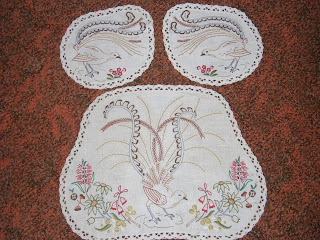This blog was created to tie in with the exhibition of my linens held at Bundoora Homestead Art Centre, Vic. from August 29 to September 16, 2012. The collection is still growing, so this blog will be updated on a regular basis as I accumulate more items. Many of these are either partially complete, or not embroidered at all. I accquire my linens from a variety of sources including opshops, garage sales, eBay, and people who know I have a passion for vintage embroidery.
Thursday, December 1, 2011
First World War memorabilia.
These were intended to be picture frames. One is left wondering if the reason they are unfinished was that the men whose photos were supposed to be framed, never came home.
Various early to mid 20th century work.
Sauce Bottle covers. These items were also made in crochet work.
Sandwich tray doilies.
Set of napkin/serviette holders. Each one wrapped a napkin and was fastened by slipping one end into a slot at the other end.
Doiley celebrating a Brisbane anniversary.
Two Australiana centrepieces.
Here are two versions of the same pattern. It is interesting to see how individual embroiderers interpret designs and choose colours.
Doiley with parrots.
Beautifully stitched Blue Wren centrepiece.
Unusual sailing ship centrepiece.
Thatched cottage table runner, obviously more English than Australian, but I have no idea where this design originated. I believe it was stitched here.
Royalty design probably celebrating a royal visit or coronation.
Scotty dogs, one each end of a table runner.
Art deco style centrepiece.
Sandwich tray doilies.
Set of napkin/serviette holders. Each one wrapped a napkin and was fastened by slipping one end into a slot at the other end.
Doiley celebrating a Brisbane anniversary.
Two Australiana centrepieces.
Here are two versions of the same pattern. It is interesting to see how individual embroiderers interpret designs and choose colours.
Doiley with parrots.
Beautifully stitched Blue Wren centrepiece.
Unusual sailing ship centrepiece.
Thatched cottage table runner, obviously more English than Australian, but I have no idea where this design originated. I believe it was stitched here.
Royalty design probably celebrating a royal visit or coronation.
Scotty dogs, one each end of a table runner.
Art deco style centrepiece.
Monday, November 28, 2011
Wednesday, November 16, 2011
Tray Cloth
This is a very unusual (to me) tray cloth produced by Semco. It is quite unlike any of their other designs, although the illustrations on the stitching guide indicate several other designs in the series. This one shows the Melbourne skyline with Princes Bridge on the Yarra River. From the lack of tall buildings, this has to pre-date the 1950's!
"Wartime Productions"
I have two unworked doilies which are a mystery to me, and nobody can shed any light on them. They both have the words 'Wartime production' stamped on the side of the design. I would love to know more about the meaning of these.
Trousseau Sets.
A few generations ago, girls would buy or make household linens for their trousseau or 'glory box'. We had tablecloths, doilies, aprons, tea cosies, etc. lovingly stashed away in a trunk or box, waiting for the day we got married and moved into our own home and could use them. The designers of linens took advantage of this and produced all kinds of sets ready to embroider, sometimes sold through women's magazines. Here are two such items. One is partially embroidered, with the tea cosy finished. I always wonder about the background of these. Was this set being worked on during the War? Perhaps her man never came back, and this was abandoned in the grief of her loss.
The other one distributed through New Idea magazine, has part of one doiley stitched. If it had been mine, I can sympathise with the stitcher, taking a while to do this small bit, then looking at the total area still to be done, and thinking "No way!"
The other one distributed through New Idea magazine, has part of one doiley stitched. If it had been mine, I can sympathise with the stitcher, taking a while to do this small bit, then looking at the total area still to be done, and thinking "No way!"
Subscribe to:
Comments (Atom)



















































